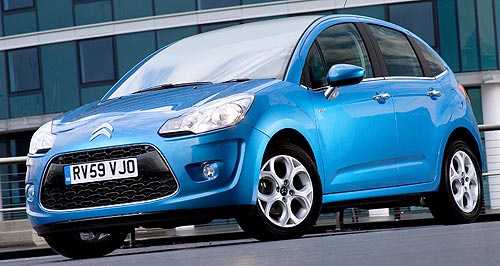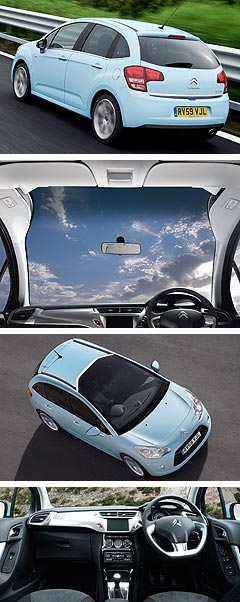First drive: New Citroen C3 piles on the style
BY JOHN WRIGHT | 16th Nov 2010

Priced from $19,990 for the 1.4-litre VT five-speed manual, the all-new French light-car significantly undercuts the old model, which cost a steep $23,990, but might struggle against rivals such as Volkswagen’s latest Polo (from $16,690) and Suzuki’s Swift, which has a similar kind of perky aesthetic to the Citroën but currently enters the fray at $16,290 – at least until its redesigned successor arrives early next year.
The second-generation C3 has a far more stylish and innovative interior than its predecessor. Superior quality plastics, including a stylish new soft-feel dash, are used throughout and the sibling relationship with the more upmarket DS3 three-door (with which it shares its architecture) is evident in the new car.

Literally a highlight of the new C3 is the ‘Zenith’ panoramic windscreen on the premium Exclusive variant, which makes Citroën’s boast of a “touch of glass” seem modest, this screen being as deep at 1.35 metres as it is wide and occupying almost as much space as the steel roof behind it.
The Zenith screen adds a great sense of airiness and space to what is now one of the most compact vehicles in the segment (at just 3.94 metres in length). The notably thin A-pillars serve not only to accentuate the glassy feel but act as a reminder that the second-generation C3 really is a new design (fat, vision-impairing A-pillars being a negative on its predecessor).
Citroën Australia claims the boot as the segment’s biggest at 300 litres, accessed via a sill just 22.7mm higher than the boot floor. There are four lashing rings but a removable load net costs extra. A box measuring 1029x1189x689mm, says Citroën Australia, can be accommodated with the split/folding rear seat in the down position.
Equipment levels on the VT variant are far from lavish and it has obviously been specced-down to that important $19,990 price point. It gets air-conditioning but no cruise control and also lacks the USB and Bluetooth connectivity which are optional on the VTR+ and standard on the Exclusive.
Steel wheels are standard with same-size 15-inch alloys optional. Drum brakes are used on the rear wheels, while the 266mm front discs are 20mm smaller than on other C3s. There are wind-up windows in the back and the full size curtain airbags of the upmarket versions are not fitted.
However, the VT is equipped with the now expected plethora of safety features, including ABS (anti-lock brakes), EBD (electronic brake-force distribution), EBA (emergency brake assist) and ESP (electronic stability control), as well as the bonus of automatic hazard light activation on rapid deceleration.
The VT is powered by a carryover 1.4-litre petrol engine that develops a modest 54kW – down from 63kW for the (three-door) Polo entry model and 75kW for the Swift. The VT weighs 1030kg and the maker claims a zero to 100km/h time of 14.2 seconds, which is a figure typical of this segment in about 1990.
VTR+ and Exclusive customers have a choice between the much lustier 88kW 1.6-litre petrol unit or the remarkably fuel-efficient 1.6-litre turbo-diesel with 66kW of power and a more telling 215Nm of torque at just 1750rpm.
Choose diesel and you get a five-speed manual gearbox but the petrol 1.6 is only available with the four-speed automatic transmission. Claimed 0-100km/h times for these models are closer to the segment norm at 11.0 and 10.9 seconds respectively.
The VTR+ opens its account at $23,490 with the petrol engine and automatic transmission, while the HDi manual adds $500 to the price.
Cruise control with speed-limiter, rear disc brakes, front foglights, velour trim, a leather steering wheel and cooled glovebox are standard. There is a centre rear head restraint and enhanced trim details such as body-colour door-handles and a chrome exhaust outlet are further points of differentiation.
The flagship C3 Exclusive costs $25,990 with the 1.6-litre petrol engine and four-speed automatic or $26,490 as a manual HDi.
As well as the desirable Zenith windscreen it adds climate-control, USB and Bluetooth connectivity ($700 on the VTR+), a front centre armrest, heated electric mirrors, dark-tint rear windows, a body-colour front bumper and plenty of chrome highlights (notably the window trims). Faux brushed steel on the lower dash and a gloss black centre console enhance the interior ambience.
Sixteen-inch steel wheels in this age of alloys are standard on even the Exclusive, although 15-inch alloys (for the VT and VTi) and 16 and 17-inch alloys (for the Exclusive) are available as a dealer-fit option at an unspecified price.
Rear parking sensors are a $500 option on the VT and VTR+, while metallic/pearlescent paint costs $800 on all models and a ‘climate pack’ is a $1000 option on the VTR+ and Exclusive.